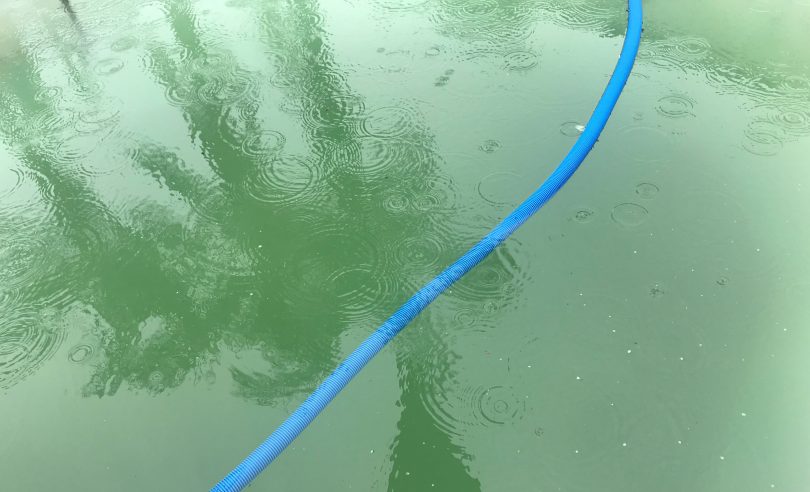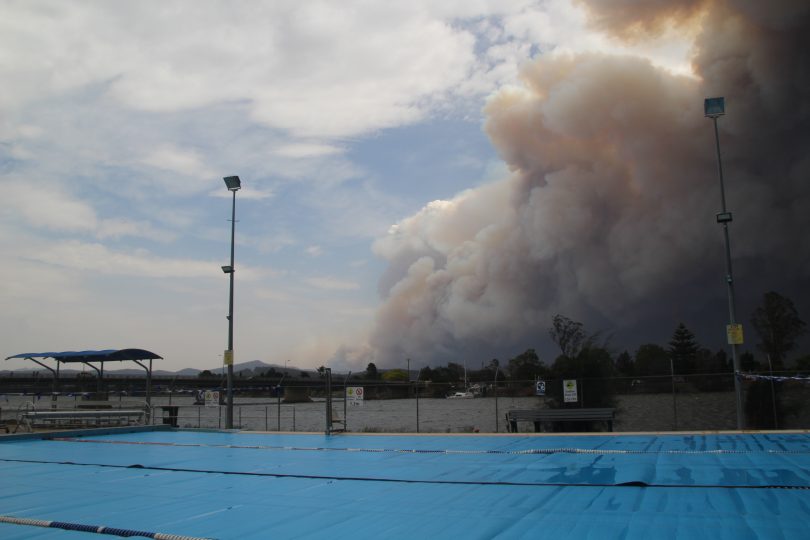
That murky pool will require a lot of work before use. Photos: Alex Rea.
Anyone with a pool knows that they can be a lot of work, but can also be a lot of fun.
With the bushfires bearing down on towns across the country, many pool owners will have felt some despair at the sight of their pools looking like a wet ashtray. Even pool covers may not have been enough to keep the ash out.
Power outages may have also set back filtration while some pools may have become a welcome water resource for firefighters.

Moruya Swimming Pool was covered and closed for a few days over New Year.
After keeping the pool clean through the winter, many will now be out of bounds in these hot months until they’re cleaned up, and it will take some time and patience to get rid of the fine ash and back to their crystal-clear best.
It means people like ‘Paul the Pool Bloke’ from Bay Pool Services at Batemans Bay are going to be very busy.
“Virtually all the pools in the area have been affected by power outages, some for two weeks,” Paul says. “Chlorine levels are very low and combined with the ash and burnt organic material, and a bit of rain washing algae spores into the pool, has created the perfect conditions for the dreaded ‘green pool’ event.”

Ash sludge in the pool from bushfires.
When the power is out, Paul says “the only answer is chlorine added to the pool water”.
“When power is restored, turn your chlorinator up to 90 per cent for as many hours as you can afford. If your water level is low, remember to turn off your pump, as your pump may run dry when power is restored and that will damage your pump.
“If you catch the green monster early, you will avoid the likelihood of your pool becoming a mosquito swamp driving you and your neighbours mad. If you or a neighbour has had to abandon a property with a pool either shock it with chlorine or inform the council.”
Paul has more advice when it comes to chlorine – especially if you try to cut corners with cut-price chemicals.
“Be aware that cheap chemicals will need to be added at at least double the quantities recommended as our computer water testing machines are calibrated for use with our high-quality brand chemicals.”
Another tip is to use an old stocking over your pool skimmer box to catch the finer particles. You can also stretch one over your pool scoop.
Bay Pool Services is inside BBQs Galore Batemans Bay and they have some ‘Cheat Sheets’ available to advise how to clean up your ash-filled pool, depending on filter type.
“We hope you can salvage some pool use before winter,” says Paul.
Tips
Vacuuming to waste is available to all media filters but it is only an option for cartridge filters if they have a dedicated waste line plumbed in (that is, they can remove water from the pool with a three-way valve).
First, ensure your pool water level is topped up to the absolute maximum. (You may even need to top up your pool water level while vacuuming – if so, add the water to the top of the pool so the floc/sediment on the bottom of the pool is not disturbed.)
Liquid Floc
Test the pool water and adjust pH to 7.6 or above and Alkalinity to 80 ppm or above.
Turn filter valve to recirculate/bypass (or remove filter element for cartridge filters).
Dilute prescribed amount of Quickfloc into a bucket or water and add evenly to the pool.
Leave pump on for 1 to 2 hours then switch off and allow all particles to settle to the floor of the pool.
With the filter valve set to waste (or the bypass valve opened on the line after the cartridge filter and waste line attached), vacuum the pool manually, vacuuming all the flocked particle to waste.
After vacuuming, return valve to filter (or close bypass valve and refit cartridge element), top-up pool to the normal water level, return to filtering for a further six hours.
Follow up with a bling tablet to catch any remnants if necessary.
Test and chemically re-balance the pool as necessary before swimming.

That crystal clear pool you are after.
Remember that the water restrictions in Council areas vary.
In Eurobodalla https://www.esc.nsw.gov.au/council-services/water-waste-recycling/water-and-sewer/water-restrictions
In QPRC https://www.qprc.nsw.gov.au/Services/Water-restrictions-and-conservation-measures
https://www.qprc.nsw.gov.au/News-Media/Water-restrictions-for-Bungendore-and-Braidwood-residents.







